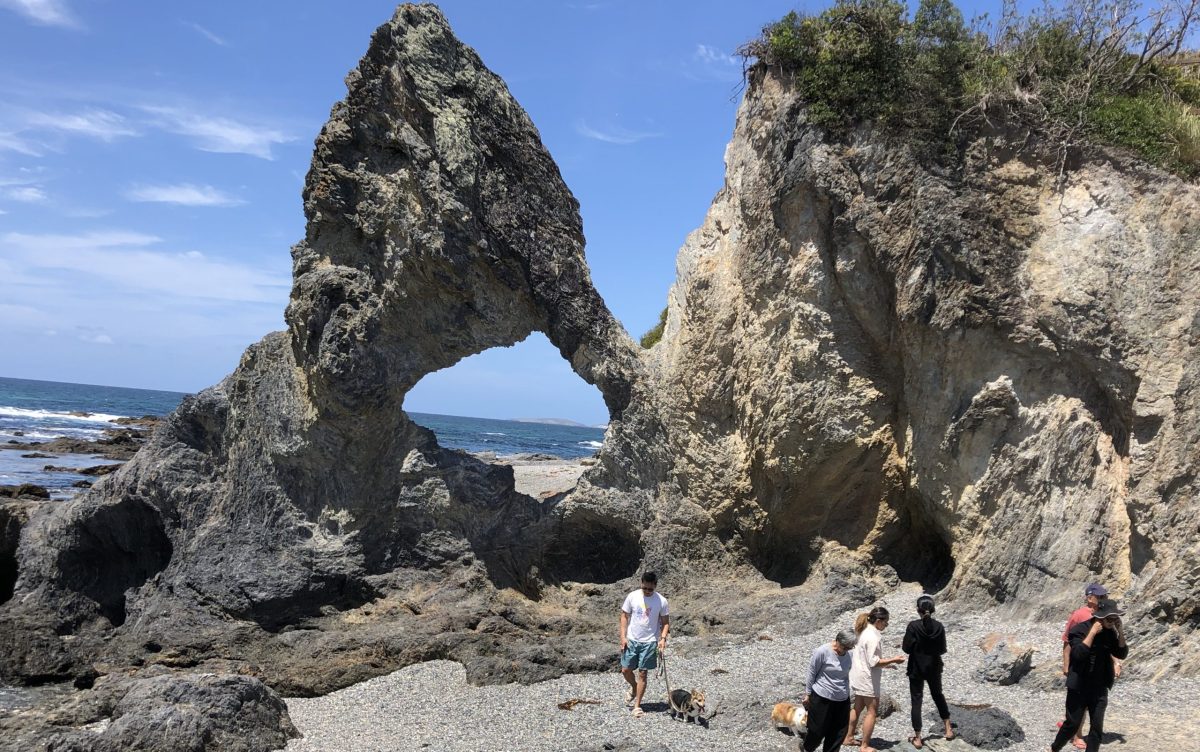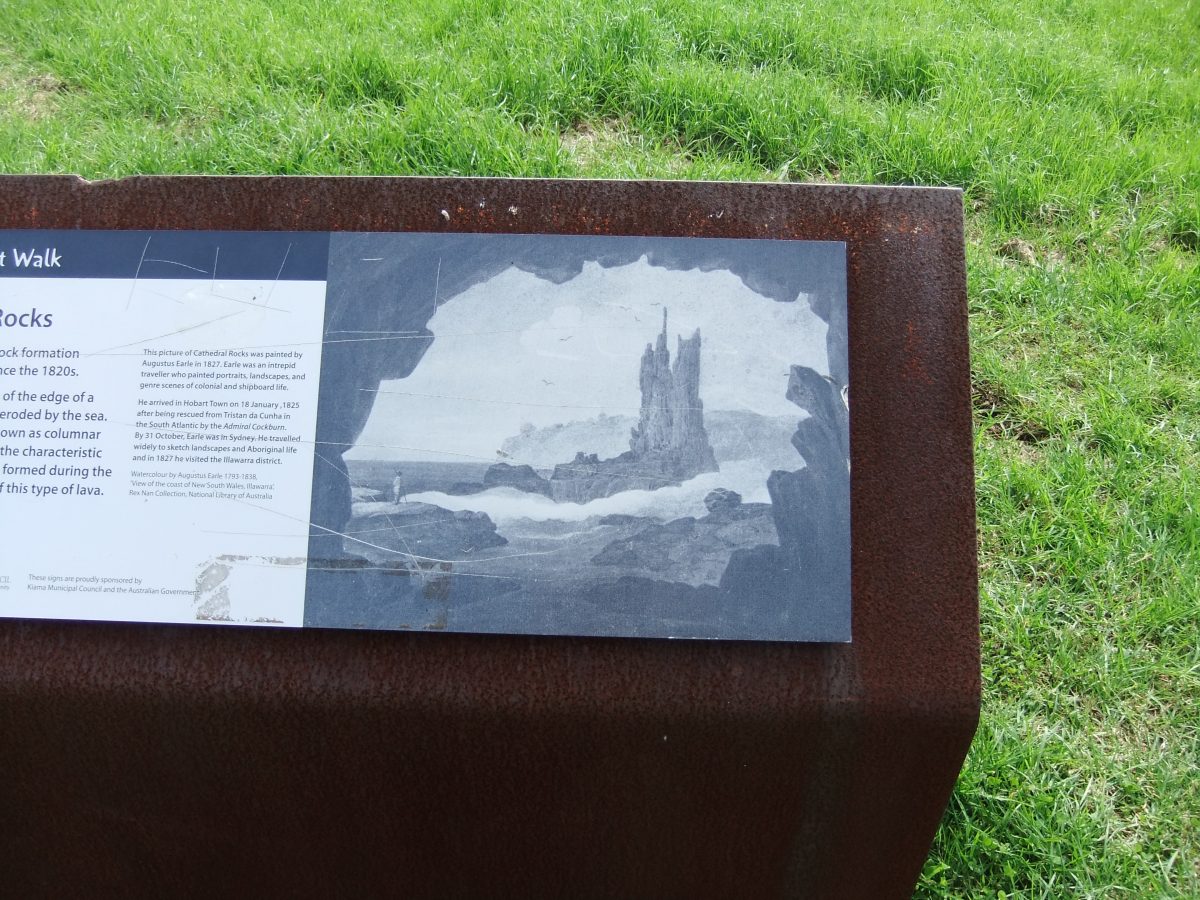
Australia Rock is a very popular tourist attraction in Narooma but the join with the cliff face is much narrower than it was 80 years ago. The hole in the centre has also changed considerably. Photo: Marion Williams.
Throughout the year visitors to Narooma make a beeline to Australia Rock to take photographs of the unique rock formation. It is difficult to believe that it looked entirely different 80 years ago.
That raises the question: will Australia Rock still be around in 80 years’ time?
Retired geologist and honorary fellow of the University of Wollongong Chris Fergusson won’t hazard a guess how long Australia Rock will last but said “a really big wave coming in the wrong direction could take it out in one go”.
An old postcard dated 1941 has a photograph of what was then called ‘The Peephole’. As the name implies, the hole in the centre of the rock was smaller and there was only a hint of the outline of Australia.

A picture of what was called ‘The Peephole’ in Narooma on a postcard dated 1941. The join with the cliff face was much wider than it is now. Photo: Supplied.
Australia Rock owes its existence to its geology and coastal erosion in recent decades.
Those two forces will inevitably see it disappear.
Compared with the old photograph, the join between Australia Rock and the headland has dramatically narrowed.
Mr Fergusson has studied the geology of the area extensively and continues to do so.
He said the rock in that area was Narooma chert and was basically silica cement. It tends to make a rock very hard because it is made of quartz – quite a hard mineral.
All rocks have weaknesses though, and it is the weakest part of the rock that determines the strength of the rock mass.
“In these rocks we have lots of bedding planes and we also have cracks,” Mr Fergusson said.
That means even though the rock itself is very hard and very hard to break down, it is very easy to break off a bit from the rock face because there are lots of little cracks in there.”
To put that into context, while granite bedrock may have cracks metres apart, the cracks in Narooma chert are only 10 to 20 centimetres apart.
“So, it is quite easy to break off slabs of chert, but the actual rock itself is much harder to break unless you are breaking it along a crack,” Mr Ferguson said.

A painting from around 1827 shows how tall the sea stack, known as Cathedral Rocks, used to be. Photo: Supplied.
The Narooma cherts are 450 to 500 million years old. They were formed from mud on the sea floor.
“What you are seeing around Narooma is chert that formed in the ancient Pacific Ocean in very deep water, something like the present Tasman Sea, 4000 to 5000 metres deep, probably even deeper.
“That sediment ends up getting deformed or squeezed, like the Himalayas were formed through two tectonic plates colliding,” he said. “The mud at the bottom of the ocean was squashed and squeezed up by the two plates.”
Mr Fergusson said most of the damage to Australia Rock would be caused by six- to eight-metre storm waves in the winter.
“It is very difficult to predict how long it will take,” he said. “Overall, it is slow.”
In other parts of the world though, such as the northeast of the United States, there are places where the sea is advancing by a metre or more every year, which is very fast. That is because there are no rocky headlands, only sand.
The rock headlands of the NSW South Coast make the rate of erosion much slower.
“That doesn’t mean it isn’t happening, but it gives people a false sense of security.”

The impact of coastal erosion on Cathedral Rocks is obvious when comparing how they looked in the painting completed around 1827 and how much smaller they were in this photograph from 2014. Photo: Supplied.
He gave the example of Cathedral Rocks at Bombo, north of Kiama. “Someone did a painting of them in 1827. It was a sea stack but has significantly eroded since that time.”
The steady impact of coastal erosion is very evident at Wollongong Harbour.
The columnar basalt blocks quarried at Kiama are too small to prevent erosion at Wollongong Harbour, so engineers use larger concrete blocks instead.
“They have to replace a number of those each year, so we are talking about big blocks of rock being worn down very quickly because of erosion.”
Mr Fergusson said coastal erosion would be an increasing problem.
“As the sea levels rise, the oceans get warmer and with the greater intensity of storms, it is going to be a harder world to live in and I guess we are seeing that.”
Original Article published by Marion Williams on About Regional.












